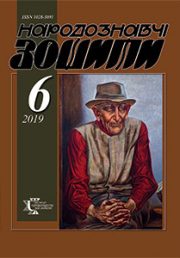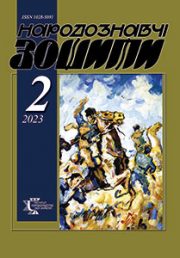The Ethnology Notebooks. 2024. № 5 (179), 1181—1193
UDK: 94(4):94(470+571):94(474.5):342.7:329.1
DOI https://doi.org/10.15407/nz2024.05.1181
NECHESNYI Nazar
- ORCID ID: https://orcid.org/0009-0004-4855-7825
- Graduate Student,
- Ivan Franko National University of Lviv,
- Department of History of Central and Eastern Europe,
- 1, Universytetska str., 79000, Lviv, Ukraine,
- Contacts: e-mail: nechesny@gmail.com
Abstract. Introduction. Human rights have been an important topic of public discourse since the late 1960s. In the early 1970s, the human rights strategy of dissidents became the main one in the USSR. The use of this strategy can be traced in many republics that were part of the Soviet Union.
Problem Statement Researchers rarely consider dissident movements in the USSR in terms of their human rights activities. And most of the studies that deal with this issue mainly focus on russian dissidents or sometimes ukrainian ones. However, the lithuanian case is no less interesting, as it provides new information for understanding the dissident movement in the USSR in general.
Purpose. To reveal the role and importance of human rights for lithuanian dissidents in the 1970s.
Methods. The principles of historicism, multifactoriality, theoretical analysis, generalization, and comparison lay the ground for our study.
Results. In Soviet Lithuania, the struggle for human rights was marked by two main approaches. The first approach, focusing on the protection of national and religious rights, was implemented through the activities of the Catholic Church. Catholics actively opposed the repressions using various forms of protest, including petitions and actions. In contrast to the Catholics, the Lithuanian Helsinki Group, founded in November 1976, represented a cosmopolitan approach to human rights protection. This group almost completely ignored the national question, focusing on universal human rights. In general, Lithuanian dissidents in the 1970s actively used the human rights strategy. It was attractive to Lithuanians because it offered a peaceful and moral character to the struggle against the Soviet system. Scholars call this the principle of «dissident legalism», which involves fighting against the system without going beyond it.
Conclusion. The Lithuanian dissident movement of the 1970s demonstrates how the adaptation of all-Union human rights strategies to local conditions ensured significant impact and scale. Religious activity and high public support in Soviet Lithuania contributed to the relative effectiveness of the human rights strategy. The experience of Lithuanian dissidents who integrated human rights principles into the context of national and religious issues is important for understanding the overall dissident movement in the Soviet Union, and highlights how specific conditions can affect the scale and impact of such initiatives.
Keywords: human rights, Soviet Lithuania, dissident movement, Lithuanian Helsinki Group, samvydav, national question.
Received 10.09.2024
REFERENCES
- Moyn, Samuel. (2010). The Last Utopia: Human Rights in History. Cambridge: MA: Harvard University Press.
- Ventslova, T., Donskis, L., & Yefremov, G. (2016). Premonitions and Prophecies of Eastern Europe. Kyiv: Dukh i Litera [in Ukrainian].
- Vardys, Stanley V. (1987). The role of the churches in the maintenance of regional and national identity in the Baltic Republics. Journal of Baltic Studies, 3 (Vol. 18, pp. 287—300). DOI:10.1080/01629778700000141
- Vardys, Stanley V. (1981). Human rights issues in Estonia, Latvia, and Lithuania. Journal of Baltic Studies, 3 (Vol. 2, pp. 275—298). DOI: 10.1080/01629778100000251
- Kowalewski, D. (1979). Dissent in the Baltic republics: Characteristics and consequences. Journal of Baltic Studies, 4 (Vol. 10, pp. 309—319). DOI: 10.1080/01629778100000251
- Kowalewski, David. Lithuanian protest for human rights in the 1970s: Characteristics and consequences. Retrieved from:
- http://www.old.lituanus.org/1979/79_2_03.htm#ref (Last accessed: 07.04.2024).
- Kowalewski, D. (1980). Protest for Religious Rights in the USSR: Characteristics and Consequences. The russian Review, 4 (Vol. 39, pp. 426—441). DOI: 10.2307/128810
- Rubenstein Joshua. (1980). Soviet dissidents: their struggle for human rights. Boston, MA: Beacon Press.
- Misiunas, Romuald J., & Rein Taagepera. (1933). The Baltic States, years of dependence, 1940—1990. Berkeley: University of California Press.
- Kung, Andres. (1990). A dream of freedom: four decades of national survival versus russian imperialism in Estonia, Latvia, and Lithuania, 1940—1980. Cardiff; New York: Boreas.
- Daniel, Thomas. (2001). The Helsinki Effect: International Norms, Human Rights, and the Demise of Communism. Princeton; N.J.: Princeton University Press.
- Snyder, Sarah. (2011). Human rights activism and the end of the Cold War: a transnational history of the Helsinki network. Human Rights in History. New York: Cambridge University Press.
- Snyder, Timothy. (2003). The Reconstruction of Nations: Poland, Ukraine, Lithuania, Belarus, 1569—1999. New Haven, Connecticut: Yale University Press.
- Vardys, Stanley V. (1997). Lithuania: The Rebel Nation. Boulder: Westview Press.
- Girnius, S., & Sabrina, S. (Ed.). (1989). «Catholicism and nationalism in Lithuania,» in Religion and Nationalism in Soviet and East European Politics (Pp. 109—137).Durham: Duke University Press.
- Vasiliauskaite, Vilma. (2006). Periodical of Lithuania and Central Eastern European countries, 1972—1989. Vilnius: LGGRTC [in Lithuanian].
- Madsen, Richard, & Stephen, A. Smith. (Ed.). (2013). «Religion under Communism». In: The Oxford Handbook of the History of Communism (Pp. 585—601).Oxford: Oxford University Press.
- Self-immolations and national protest in lithuania.Retrieved from:http://www.old.lituanus.org/1972/72_4_04.htm (Last accessed: 07.04.2024).
- Anusauskas, Arvydas. KGB Reaction to the Events of 1972. Retrieved from:http://www.genocid.lt/Leidyba/13/aarvydas.htm (Last accessed: 07.04.2024) [in Lithuanian].
- Russification. The New York Times, Thursday, July 6, 1972 (Editorial). Retrieved from:http://www.old.lituanus.org/1972/72_2_02.htm (Last accessed: 07.04.2024).
- Vardys, Stanley. Protests in lithuania not isolated. Retrieved from:http://www.old.lituanus.org/1972/72_2_01.htm (Last accessed: 07.04.2024).
- Zakharov, Boris. (2003). Essays on the History of the Dissident Movement in Ukraine (1956—1987). Kharkiv: Folio [in Ukrainian].
- Siromskyi, Ruslan. (2020). Human Rights in the Ukrainian SSR: A Canadian Perspective (1945—1991). Lviv: Triada Plus [in Ukrainian].
- The Five and the Five. 5 KGB Directorate. Programme Eight Sergei Kovalev and Case, 345. Radio Liberty, 2012. Retrieved from: https://www.svoboda.org/a/24717637.html (Last accessed: 07.04.2024) [in russian].
- (1979). Chronicle of the Lithuanian Catholic Church (Issues 9, 10, 11, 18, 19, 28, 29). New York: Chronicle [in russian].
- National and religious protest in lithuania. From the underground chronicle of the catholic church in lithuania. Part one. Retrieved from: http://www.old.lituanus.org/1974/74_2_05.htm (Last accessed: 07.04.2024).
- National and religious protest in Lithuania. From the underground chronicle of the catholic church in Lithuania (Part three).Retrieved from: http://www.old.lituanus.org/1974/74_4_07.htm (Last accessed: 07.04.2024).
- In a Soviet school. Retrieved from: https://lkbkronika.lt/index.php/22-kronika-1976-m/998-tarybineje-mokykloje (Last accessed: 16.06.2024) [in Lithuanian].
- Kopecek, Michal, Donert, C., Kladnik, A., & Sabrow, M. (Eds.). (2022). Dissident Legalism: Human Rights, Socialist Legality, and the Birth of Legal Resistance in the 1970s Democratic Opposition in Czechoslovakia and Poland. In: Making Sense of Dictatorship: Domination and Everyday Life in East Central Europe after 1945 (Pp. 241—269). Budapest: CEU Press. 30. Lukianenko, Levko. Confession on death row. Zhurnal «Vitchyzna»; hazeta «Dilova Ukraina» [in Ukrainian].
- Another victim was lured by the graves… Retrieved from:https://lkbkronika.lt/index.php/23-kronika-1976-m/1039-dar-viena-auka-paviliojo-kapai (Last accessed: 16.06.2024) [in Lithuanian].
- Kasyanov, Heorhii. (1995). Dissenters: Ukrainian Intellectuals in the Resistance Movement of the 1960s—1980s. Kyiv: Lybid [in Ukrainian].
- The Violations of Human Rights in Soviet Occupied Lithuania: A Report. Retrieved from: http://www.old.lituanus.org/1975/75_1_06.htm (Last accessed: 07.04.2024).
- Estonian and latvian memorandum to the conference on security and cooperation — 1975. Retrieved from: http://www.old.lituanus.org/1975/75_3_09.htm (Last accessed: 07.04.2024).
- Bungs, D. (1988). Joint political initiatives by Estonians, Latvians, and Lithuanians as reflected in samizdat materials 1969—1987. Journal of Baltic Studies, 19 (3), 267—271. DOI: 10.1080/01629778800000181
- Hryhorenko, Petro. (1984). Memoirs. Detroit: Ukrainski Visti [in Ukrainian].
- (1977). Collection of documents of the public group of assistance to the implementation of the Helsinki Accords (Issue 3).New York: Chronicle[in russian].
- Gustaitis, R. The Lithuanian Helsinki Group and one of its inspirers — E. Finkelstein. Retrieved from: https://www.bernardinai.lt/2011-12-23-rolandas-gustaitis-lietuvos-helsinkio-grupe-irvienas-is-jos-ikvepeju-e-finkelsteinas/ (Last accessed: 07.04.2024) [in Lithuanian].
- The case of the lithuanian helsinki group leader Viktoras Petkus. Retrieved from: http://www.old.lituanus.org/1979/79_2_04.htm (Last accessed: 07.04.2024).
- (1979). Collection of documents of the public group of assistance to the implementation of the Helsinki Accords (Issue 5).New York: Chronicle [in russian].
- (1978). Collection of documents of the public group of assistance to the implementation of the Helsinki Accords (Issue 4). New York: Chronicle [in russian].
- Document No 17 of the Final Act of the Lithuanian Group in Support of the Resolutions of the Helsinki Consultation. Retrieved from: http://www.genocid.lt/Leidyba/7/helsinkio_pasitarimas.htm (Last accessed: 07.04.2024) [in Lithuanian].
- Girnius, S. Current events: the demise of the Lithuanian Helsinki Group. Retrieved from: http://www.lituanus.org/1984_2/84_2_05.htm#Ref (Last accessed: 07.04.2024) [in Lithuanian].
- (1982). Implementation of the Final Act of the Conference on Security and Cooperation in Europe: findings and recommendations seven years after Helsinki. Report submitted to the Congress of the United States by the Commission on Security and Cooperation in Europe. November 1982. Washington, D.C.: U.S. Government Printing Office.
- Eitan Finkelstein, Interview taken 18 June 2004. Retrieved from: http://surl.li/divsc (дата звернення: 07.04.2024) [in russian].
- Greetings to Pope John Paul II. Retrieved from: https://lkbkronika.lt/index.php/35-kronika-1978-m/1500-sveikinimas-popieziui-jonui-pauliui-ii (Last accessed: 16.06.2024) [in Lithuanian].
- Catholic Committee for the Defense of the Rights of the Faithful. Retrieved from: https://lkbkronika.lt/index.php/36-kronika-1979-m/1533-tikinciuju-teisiu-gynimo-kataliku-komitetas (Last accessed: 16.06.2024) [in Lithuanian].
- Alexeeva, Lyudmila. (20120. History of dissent in the USSR: the newest period. Moscow: MHG [in Russian].
- (2014). The Incorrigible: memoirs of Monsignor Alfonso Svarinskas. Vilnius: Versme [in Lithuanian].
- A few strokes for the portrait of Monsignor Alfonso Svarinskas. Retrieved from: https://www.xxiamzius.lt/numeriai/2005/03/10/laikzmon_01.html (Last accessed: 07.04. 2024) [in Lithuanian].
- Fighting for the church in Klaipeda. Retrieved from: https://lkbkronika.lt/index.php/41-kronika-1980-m/1858-kova-uz-klaipedos-baznycia (Last accessed: 07.04.2024) [in Lithuanian].





